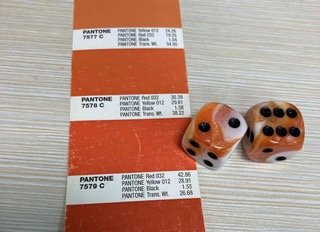Dicey Dice & a Lesson in Community
I put out an update on Nut Hunt earlier this week and included a section about a bit of a hiccup with our dice.
Our first batch of 4,000 dice came out not quite as we had hoped. Here they are for reference.
We have 4,000 of these shipping stateside with our games… what should we do with them?
The dice aren’t bad - they just aren’t perfect.
We think the problem is that we used an orange + white + marbled effect, whereas we should have used an orange + clear orange + white + marbled effect to achieve a look closer to our reference die.
It’s also worth noting that this was our second iteration of dice, our first iteration was blended instead of marbled due to poor communication (luckily it was only for a couple of prototypes).
Left: initial non-marbled prototype we rejected, Right: Chessex Orange Vortex & Black die we are referencing for our marbled effect.
The white in the first marbled batch was also a little cool, and it might be the lighting but the orange felt a little browned to my eye.
We’ve ordered a new batch of dice with the orange + clear orange + white + marbled effect a warmer white, and a slightly different primary orange. And, we’re getting a sample made before the the mass-run.
Takeaways
There are a couple of lessons here.
First, after changing the die versus our production prototype we should have done a another small batch run before the main production run.
Second, the bigger takeaway has been the community responses to my update.
I try to be fairly transparent with the behind the scenes at Pine Island, even when it’s hard (like here, and here). I think it is more useful to our supporters and community if we share not only our triumphs, but also our challenges.
Talking about the dice was kind of a throwaway. It was a mistake we made, learned from, and were rectifying. And it didn’t directly impact anyone other than a little extra money we had to spend to fix it.
But, talking about it built a lot of good will with our backers.
It’s a lesson that I’ve been learning since we launched Pine Island Games. The fact that we are a small independent publisher makes us relatable. Vulnerability and honesty can add to that relatability.
But, tone is massively important.
If we had just presented the problem (we manufactured dice that aren’t up to our expectations), without other context or next steps, I think it would have fallen flat. It would have come off as negative, and maybe a little whiny.
But that isn’t what we did. We presented a problem, a solution, and steps that we are taking to achieve that solution.
So, by talking about the dice we earned trust with our backers, we connected with our community, and we improved our reputation as a company that cares about the little things.
Communication is important. I’ve been amazed at the community and support and goodwill that is out there if we’re just willing to have a conversation.
And, it isn’t a conversation about everything going right all the time. It’s a conversation about the things that go right, the things that go wrong, and most importantly how we are growing and evolving to continue to do better.
What companies have done a good job at communicating through their mistakes?






